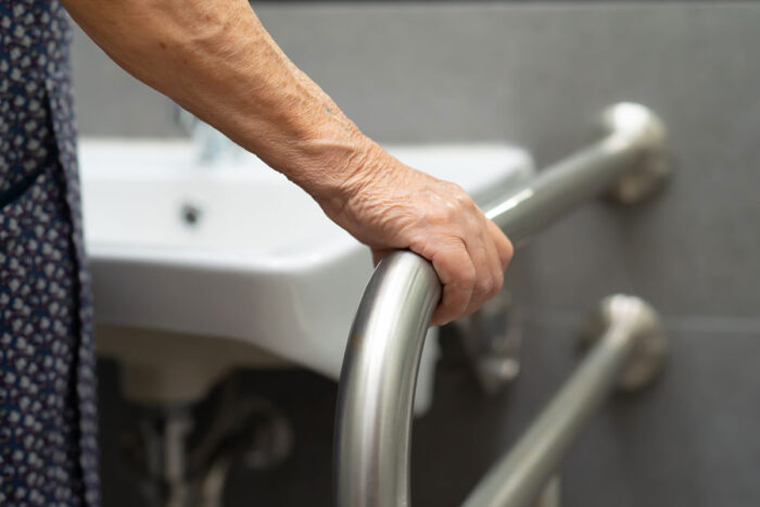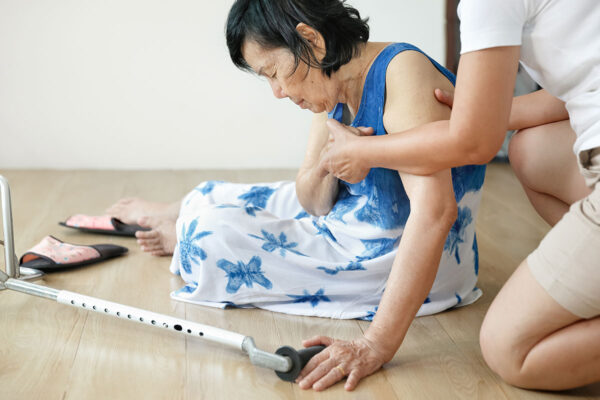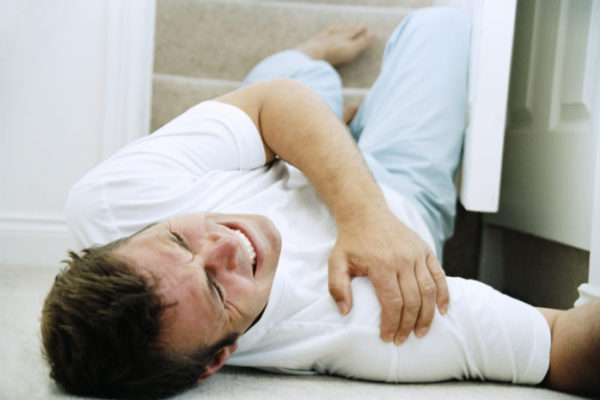For many aging Americans, the dream of maintaining an active, independent lifestyle while living at home comes crashing down with a fall. Falls are the leading cause of injury, accidental death and premature placement in a nursing home among older adults in the United States.
Now, new research from Washington University School of Medicine in St. Louis suggests that in-home falls can be reduced by nearly 40% with a community-based program that helps older adults make modifications to their homes such as adding grab bars, shower seating and slip-resistant surfaces in the bathroom, as well as lighting and handrails on staircases.
“Most falls occur at home, and while removing fall hazards in the home has been shown in other countries to reduce the risk of falls, it is not the standard practice in the U.S.,” said senior author Susan Stark, associate professor of occupational therapy, of neurology and of social work. “This study provides evidence that we can effectively deliver fall-prevention programs via community-based aging services networks rather than a traditional health-care setting,”
“Often, health-care providers have limited time with patients and fall prevention can sometimes be overlooked, especially if we don’t ask about fall risks as part of regular care,” she said.
Published Aug. 31 in the journal JAMA Network Open, the study details a 2015-17 intervention program in St. Louis in which occupational therapists visited the homes of older adults to assess fall risks and provide personalized plans to address them.
“We know that one-fourth to one-third of older adults fall annually and that half of these falls occur in their homes, so it makes sense that simple changes to the home will be effective in reducing falls,” Stark said.
Working in partnership with the St. Louis Area Agency on Aging, a nonprofit group providing nutrition, transportation and other community services, researchers identified 310 older residents at high risk of falling.
The study participants averaged 75 years of age; 50% were African American, and 75% were women. The participants were randomly divided into two groups — one receiving fall-prevention services and the other receiving standard care, such as a review of medications and referral to community resources.
“Providing the intervention in collaboration with the Area Agency on Aging allowed us to bring this service to the community and to reach those at high risk of falling who might not otherwise have received care,” Stark said. “We checked back in six months for a booster session to see how things are going and add additional support if needed. The intervention takes a few visits – and the cost was pretty modest.”
Stark’s study confirms that a low-budget, community-based fall-prevention program can be well worth the investment, with every dollar spent returning about $2 saved on medical care.
At the study’s one-year mark, the annual rate of falls per person was 1.5 falls per person in the intervention group and 2.3 falls per person in the control group. The average per-person cost of intervention was $765, and per-person declines in health-care utilization were estimated to be $1,613.
And, as this study notes, falls are costly, both in dollars and human suffering.
Falls are the most common cause of traumatic brain injury and fracture for older adults and can result in serious complications. Every 20 minutes, an older adult dies from the consequences of a fall. The annual medical costs of treating older adults for falls is estimated at $30 billion, and that figure is expected to rise as the population ages.
Although 50% of falls can be attributed to hazards in the home, simple home modifications that could help older adults stay safer and more independent usually are not covered by insurance in the United States.
“The things we do, like adding a grab bar or a tub bench to make toileting or showering safer, have to be paid for out of the pockets of older adults,” Stark said. “Many of those in our study would have lacked the resources to make these modifications on their own.”
While there is evidence to support the cost benefit of home modification in the United Kingdom, Australia and Germany, this study demonstrates the effectiveness of a community-based approach in the United States.
“Most U.S. studies have explored fall-prevention programs that partner with primary care physicians, emergency rooms or medical centers, so our partnership with a community organization is fairly unique,” Stark said.
“From a public health perspective, falls are a potentially deadly health outcome that we have the tools to prevent,” she said. “Understanding how we can efficiently deliver the intervention in the United States is an important step. I look forward to a day when fall-prevention services like those provided in this study are fully integrated into health services for older adults.”
Taking a significant step in that direction, the U.S. Department of Housing and Urban Development announced this month that it was awarding $30 million to 32 nonprofit organizations to assist elderly homeowners with home repairs and modifications, helping to ensure they age in place safely.
Provided through HUD’s Older Adults Home Modification Program, the grants will help cover the cost of home modifications for low-income seniors in rural towns and cities ranging from Long Island, N.Y., to Dubuque, Iowa, to San Antonio, including a more than a half million dollars for the Independent Living Center of Mid-Missouri, and $1 million for Mission St. Louis.
Stark S, Keglovits M, Somerville E, Hu YL, Barker A, Sykora D, Yan Y. Home Hazard Removal to Reduce Falls Among Community-Dwelling Older Adults. JAMA Network Open. Aug. 31, 2021. doi:10.1001/jamanetworkopen.2021.22044
This study was supported by the U.S. Department of Housing and Urban Development (HUD), grant number MOHHU0024-14.
Washington University School of Medicine’s 1,700 faculty physicians also are the medical staff of Barnes-Jewish and St. Louis Children’s hospitals. The School of Medicine is a leader in medical research, teaching and patient care, consistently ranking among the top medical schools in the nation by U.S. News & World Report. Through its affiliations with Barnes-Jewish and St. Louis Children’s hospitals, the School of Medicine is linked to BJC HealthCare.




Comments and respectful dialogue are encouraged, but content will be moderated. Please, no personal attacks, obscenity or profanity, selling of commercial products, or endorsements of political candidates or positions. We reserve the right to remove any inappropriate comments. We also cannot address individual medical concerns or provide medical advice in this forum.